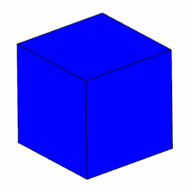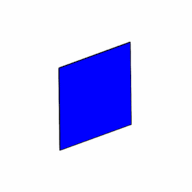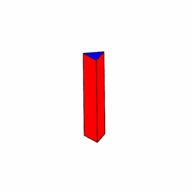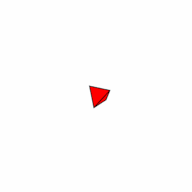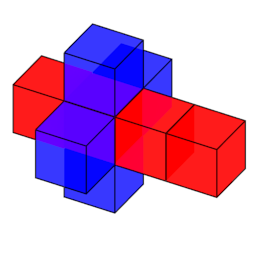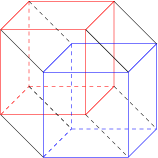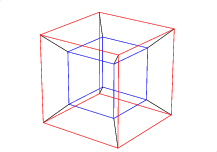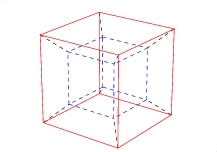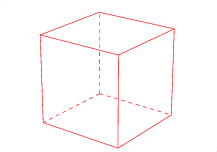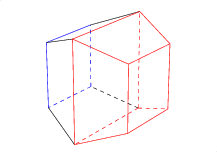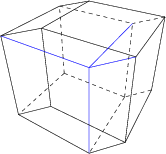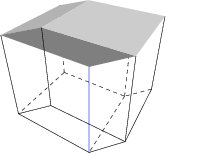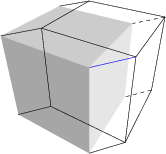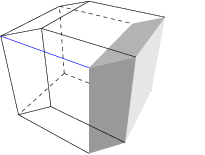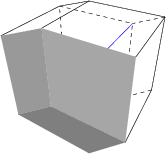Geochoron (EntityTopic, 22)
From Hi.gher. Space
The geochoron is the four-dimensional hypercube, and is perhaps the most well-known of all the 4D objects. It is known by many names, among which are the tesseract, the 8-cell, the 4D measure polytope, and the tetracube. It is also sometimes wrongly called the "hypercube" itself (a hypercube is an n-dimensional cube, not necessarily 4-dimensional). Many of these names describe its different special properties. It has been the subject of several stories, such as Robert A. Heinlein's And He Built a Crooked House. It has also been the subject of countless 4D wireframe rotation programs, screensavers, and Java applets.
It is a special case of the prism where the base is a cube, and is the 4,4-duoprism. Since it is also the result of taking the square of a square, it is also both a powertope (or triate) and a tetrate, albeit a rather trivial example of these.
Coordinates
The coordinates of a tesseract with side 2 are:
(±1, ±1, ±1, ±1)
Equations
- The hypervolumes of a tesseract with side length l are given by:
total edge length = 32l
total surface area = 24l2
surcell volume = 8l3
bulk = l4
Cross-sections
The cell-first cross-sections of a geochoron is a set of cubes of constant edge length, and the face-first cross-sections are a set of cuboids, having two axes of constant, equal magnitude (while the other axis has a variable magnitude). The edge-first cross-sections are a set of triangular and hexagonal prisms, all regular apart from the non-central hexagonal prisms, whose ends have edges of alternating widths (and equal angles). Finally, the vertex-first cross-sections are the entire spectrum of tetrahedral truncations, including forms in-between the five uniform ones; this also means that the very central such section is an octahedron.
Homology groups
All homology groups are zero unless stated. Here X is the tesseract in the given frame, and nℤ is the direct sum of n copies of the group of integers ℤ.
- 0-frame (16 points)
- H0X = 16ℤ
- 1-frame (32 line segments)
- H0X = ℤ, H1X = 17ℤ
- 2-frame (24 square faces)
- H0X = ℤ, H1X = 0, H2X = 7ℤ
- 3-frame (8 cubic cells)
- H0X = ℤ, H1X = 0, H2X = 0, H3X = ℤ
- 4-frame (solid tesseract)
- H0X = ℤ
Net
The net of a tesseract is a cube surrounded by six more cubes, with one more cube added to one of these:
Projection
There are several ways of constructing the tesseract. The simplest way is to extrude the 3D cube along the W-axis. The following projection of the tesseract underlines this method of constructing the tesseract.
Oblique Projection
The red cube shows the starting 3D cube, and the blue cube shows the endpoint of the extrusion. The black lines trace the path of the 8 vertices of the cube as it is extruded. If one examines the above diagram carefully, one will see that the tesseract in fact consists of 8 cubes. The 6 cubes besides the two obvious ones are formed by the extrusion of each of the 6 square faces of the red cube into the W-axis. These 8 cubes form the outer boundary of the tesseract.
Perspective Projections
The difficulty with the above diagram is that there are too many intersecting lines, and it is difficult to discern the 8 constituent cubes. The following diagram tries to correct this defect by using a perspective projection instead:
In this diagram the blue “inner” cube is actually the same size as the red “outer” cube, but it appears to be smaller because it is farther away along the W-axis. The 6 frustums connecting these two cubes are actually identical cubes; but they appear distorted into frustums because they are being viewed at from an angle. Furthermore, all 8 cubes lie on the outer boundary of the tesseract. Even though it appears that the inner cube is on the “inside” whereas the outer cube is on the “outside”, they actually lie on the outside of the tesseract, on two opposite sides. The following animation shows what happens when we rotate the tesseract in the XW plane.
We use dotted lines for edges that project inside the envelope of the image so that it is easier to see.
Hidden Surface Removal
One thing that is often neglected to be mentioned when such wire diagrams of the tesseract are presented is the fact that they represent projections of the tesseract without the removal of hidden surfaces. This is like showing the rotation of the wireframe of a 3D cube, where you can see through its faces and see what is on the other side of the cube. While this is useful in seeing the entire structure of the tesseract, it sometimes gives too much detail and becomes confusing. The following diagrams tries to complement the picture by showing projections of the tesseract where obscured 4D surfaces are not shown.
For example, when viewed from the angle that corresponds with the cube-within-a-cube diagram shown earlier, the tesseract in fact appears as a simple 3D cube:
When rotated 45 degrees in the XW plane, the tesseract appears as follows:
Only two cells are visible because the rest are obscured behind them in the 4th direction.
Vertex-first projection
Another fact that is often neglected when tesseract projection images and diagrams are shown is that projections such as the cube-within-a-cube actually view the tesseract from a “flat” angle, akin to looking at a 3D cube directly at one face, or perhaps at an edge, and seeing only two faces at a time. Just as we intuitively imagine the 3D cube as viewed from an angle, such that we can see three of its faces at a time, so a more “intuitive” angle of looking at the tesseract is from an angle where we can see four of its cells at once. The following diagram shows one such view of the tesseract.
The 3D surface of this projection is called a rhombic dodecahedron. It is a 12-faceted polyhedron where each face is a rhombus. The four cells of the tesseract visible from this angle are shown below:
The other four cells of the tesseract are behind these four in the 4th direction, so they are not visible. The center of this rhombic dodecahedron, where the blue edges meet, is the corner of the tesseract closest to the viewer.
Incidence matrix
Dual: aerochoron
| # | TXID | Va | Ea | 4a | C1a | Type | Name |
|---|---|---|---|---|---|---|---|
| 0 | Va | = point | ; | ||||
| 1 | Ea | 2 | = digon | ; | |||
| 2 | 4a | 4 | 4 | = square | ; | ||
| 3 | C1a | 8 | 12 | 6 | = base of prism: cube | ; | |
| 4 | H4.1a | 16 | 32 | 24 | 8 | = geochoron | ; |
Usage as facets
- prism: 10× 1-facets of a geoteron
- 3× 1-facets of a triangular triprism
| Hypercubes |
| point • digon • square • cube • geochoron • geoteron • geopeton |
| Notable Tetrashapes | |
| Regular: | pyrochoron • aerochoron • geochoron • xylochoron • hydrochoron • cosmochoron |
| Powertopes: | triangular octagoltriate • square octagoltriate • hexagonal octagoltriate • octagonal octagoltriate |
| Circular: | glome • cubinder • duocylinder • spherinder • sphone • cylindrone • dicone • coninder |
| Torii: | tiger • torisphere • spheritorus • torinder • ditorus |
| 15. 211 Cubinder | 16. 1111 Tesseract | 17. 31 Sphone |
| List of tapertopes | ||
| 3a. (II)I Cylinder | 3b. ((II)I) Torus | 4a. IIII Tesseract | 4b. (IIII) Glome | 5a. (II)II Cubinder | 5b. ((II)II) Spheritorus |
| List of toratopes | |||||
| 9. ([II]I) Crind | 10. [IIII] Geochoron | 11. <IIII> Aerochoron |
| List of bracketopes | ||

